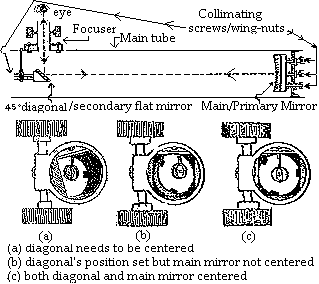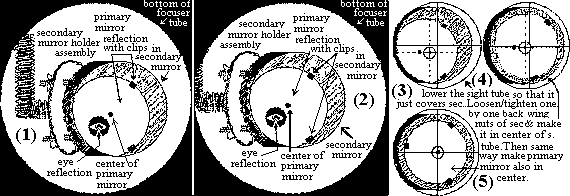|
COLLIMATION:
However, they have quite different optical components. Here I will only narrate about Newtonian telescopes, the simplest mirror telescopes. Collimating eyepiece ( or Sight Tube) You can make it from a plastic film can. White Cans are better than Black Cans because you can even use them in the dark. Drill/make a perfectly centered 2-3 mm hole in the bottom and center of the lid. Glue a cross of wires at the center of bottom hole. Wrap some tape around the Can until it fits into the focuser's inner-tube. The center of the main/primary mirror is marked with a tiny black dot.
When you look down the focuser's inner tube (also see the top diagram), the view of Diagonal Assembly should be as shown above in picture (2) above i.e. secondary mirror is almost beneath and in center of the focuser's inner pipe. If it is like picture (1) i.e. slightly towards right at 4'0 clock position make it like (2) almost in center by adjusting the 'B' plate in the diagonal assembly farther or nearer in 90 degree bent bolt. Then - 1) Slid Sight Tube (ST) into the focuser and move it downwards until the outline of the end of the tube is just slightly larger than the outline of the diag/secondary mirror ( 3rd illustration, where secondary mirror (shaded portion) has almost come inside the view of ST). 2) Make the secondary (shaded portion) centered in the ST by getting 'B' plate nearer/farther over central bent screw; also rotating it clockwise/anticlockwise (see 4th illus wherein secondary i.e. shaded portion has come almost in centre beneath focuser's inner tube). 3) Make the reflection of Primary roughly centered in the Secondary with the help of 3 wing-nuts behind Secondary Assembly plus rotating it clockwise/anticlockwise if necessary. Now only the centre spot on Primary may not match (4th illus.). 4) Make reflection of Primary Mirror centered in Sec. by respectively loosening and tightening one by one the wing-nuts behind Primary Mirror. (picture 5). Now everything is in center and you see very small centre-dot on Primary also perfect in center, congruent with the cross of the ST. 5) Rack focuser up and down and the dot on the Primary's center should always be in center, congruent with cross of ST to ensure that focuser is perfectly 90 degree above the diagonal. If not, make some sides of Focuser up or down by putting shims or some washers underneath screws so that the focuser is adjusted and the dot always remain in center while moving focuser up and down or you adjust the Secondary as described from 1 to 4. 6) Further collimation/Star Testing is done looking at a very bright star (like Sirius, Aldebran, Altair, Vega, Regulus) and making its diffraction/airy rings circular by further adjusting 3 wing nuts behind the Primary Mirror. For Star Testing minimum magnification should be 30x per inch of aperture. Here it should be 30x4.5 = 135x hence you need a eyepiece of around 7.5mm focal length. When you rack the focuser up and down this circular airy ring should remain same in size and intensity on both side of in-and-out focus which is very rare. And fortunately if that is so or near so, you have got a perfect optics which may show you beyond 30x per inch aperture of magnification. Even if your telescope doesn't pass the star test with flying colors,
don't stop enjoying your telescope, and don't worry about the star test too
much, unless it shows very obvious errors. Now your telescope is ready. You have to just fix it over any Tripod, put eyepiece in the focuser and enjoy unlimited vistas of the sky. Collimating Newtonian Optics go to : http://zebu.uoregon.edu/~mbartels/kolli/kolli.html
http://zebu.uoregon.edu/~mbartels/collimate/collimat.htm Collimating Cassegrain Telescope go to: http://www.aa6g.org/Astronomy/Articles/collimation.html http://www.torusoptics.com/collimat.htm |

